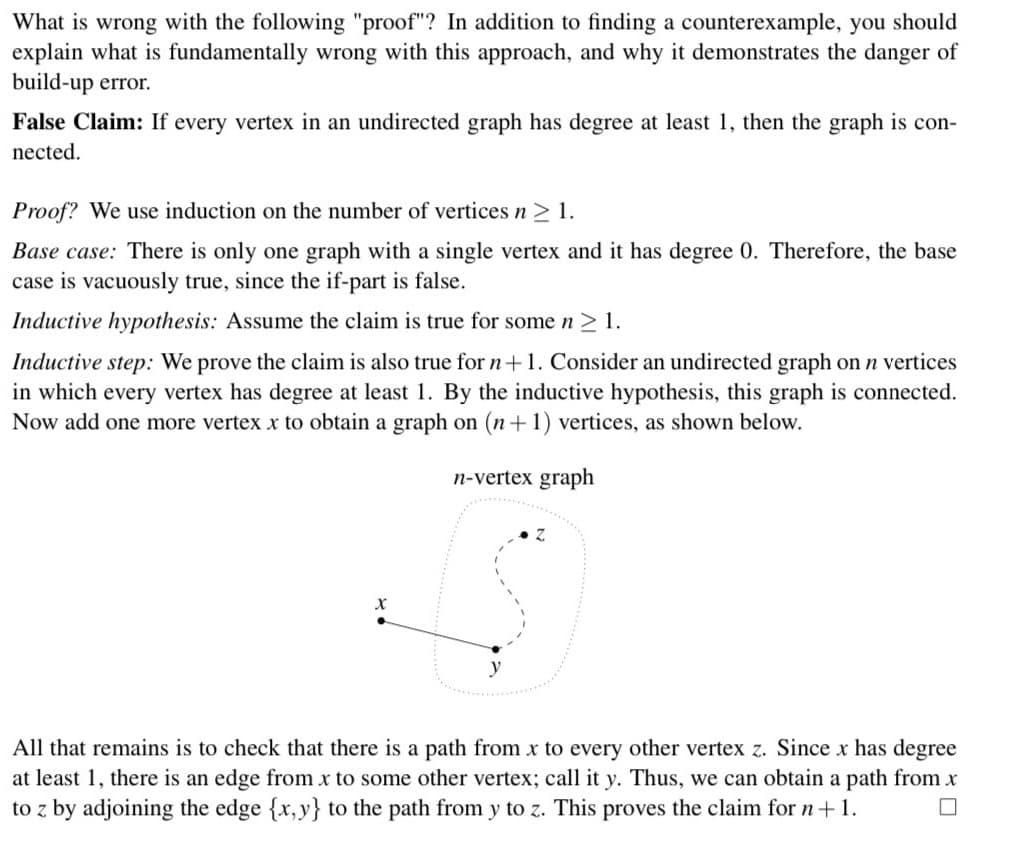What is wrong with the following "proof"? In addition to finding a counterexample, you should explain what is fundamentally wrong with this approach, and why it demonstrates the danger of build-up error. False Claim: If every vertex in an undirected graph has degree at least 1, then the graph is con- nected. Proof? We use induction on the number of vertices n ≥ 1. Base case: There is only one graph with a single vertex and it has degree 0. Therefore, the base case is vacuously true, since the if-part is false. Inductive hypothesis: Assume the claim is true for some n ≥ 1. Inductive step: We prove the claim is also true for n + 1. Consider an undirected graph on n vertices in which every vertex has degree at least 1. By the inductive hypothesis, this graph is connected. Now add one more vertex x to obtain a graph on (n+1) vertices, as shown below. n-vertex graph All that remains is to check that there is a path from x to every other vertex z. Since x has degree at least 1, there is an edge from x to some other vertex; call it y. Thus, we can obtain a path from x to z by adjoining the edge {x,y} to the path from y to z. This proves the claim for n + 1.
What is wrong with the following "proof"? In addition to finding a counterexample, you should explain what is fundamentally wrong with this approach, and why it demonstrates the danger of build-up error. False Claim: If every vertex in an undirected graph has degree at least 1, then the graph is con- nected. Proof? We use induction on the number of vertices n ≥ 1. Base case: There is only one graph with a single vertex and it has degree 0. Therefore, the base case is vacuously true, since the if-part is false. Inductive hypothesis: Assume the claim is true for some n ≥ 1. Inductive step: We prove the claim is also true for n + 1. Consider an undirected graph on n vertices in which every vertex has degree at least 1. By the inductive hypothesis, this graph is connected. Now add one more vertex x to obtain a graph on (n+1) vertices, as shown below. n-vertex graph All that remains is to check that there is a path from x to every other vertex z. Since x has degree at least 1, there is an edge from x to some other vertex; call it y. Thus, we can obtain a path from x to z by adjoining the edge {x,y} to the path from y to z. This proves the claim for n + 1.
Database System Concepts
7th Edition
ISBN:9780078022159
Author:Abraham Silberschatz Professor, Henry F. Korth, S. Sudarshan
Publisher:Abraham Silberschatz Professor, Henry F. Korth, S. Sudarshan
Chapter1: Introduction
Section: Chapter Questions
Problem 1PE
Related questions
Question

Transcribed Image Text:What is wrong with the following "proof"? In addition to finding a counterexample, you should
explain what is fundamentally wrong with this approach, and why it demonstrates the danger of
build-up error.
False Claim: If every vertex in an undirected graph has degree at least 1, then the graph is con-
nected.
Proof? We use induction on the number of vertices n ≥ 1.
Base case: There is only one graph with a single vertex and it has degree 0. Therefore, the base
case is vacuously true, since the if-part is false.
Inductive hypothesis: Assume the claim is true for some n ≥ 1.
Inductive step: We prove the claim is also true for n + 1. Consider an undirected graph on n vertices
in which every vertex has degree at least 1. By the inductive hypothesis, this graph is connected.
Now add one more vertex x to obtain a graph on (n+1) vertices, as shown below.
n-vertex graph
All that remains is to check that there is a path from x to every other vertex z. Since x has degree
at least 1, there is an edge from x to some other vertex; call it y. Thus, we can obtain a path from x
to z by adjoining the edge {x,y} to the path from y to z. This proves the claim for n + 1.
Expert Solution
This question has been solved!
Explore an expertly crafted, step-by-step solution for a thorough understanding of key concepts.
This is a popular solution!
Trending now
This is a popular solution!
Step by step
Solved in 3 steps with 1 images

Knowledge Booster
Learn more about
Need a deep-dive on the concept behind this application? Look no further. Learn more about this topic, computer-science and related others by exploring similar questions and additional content below.Recommended textbooks for you

Database System Concepts
Computer Science
ISBN:
9780078022159
Author:
Abraham Silberschatz Professor, Henry F. Korth, S. Sudarshan
Publisher:
McGraw-Hill Education

Starting Out with Python (4th Edition)
Computer Science
ISBN:
9780134444321
Author:
Tony Gaddis
Publisher:
PEARSON

Digital Fundamentals (11th Edition)
Computer Science
ISBN:
9780132737968
Author:
Thomas L. Floyd
Publisher:
PEARSON

Database System Concepts
Computer Science
ISBN:
9780078022159
Author:
Abraham Silberschatz Professor, Henry F. Korth, S. Sudarshan
Publisher:
McGraw-Hill Education

Starting Out with Python (4th Edition)
Computer Science
ISBN:
9780134444321
Author:
Tony Gaddis
Publisher:
PEARSON

Digital Fundamentals (11th Edition)
Computer Science
ISBN:
9780132737968
Author:
Thomas L. Floyd
Publisher:
PEARSON

C How to Program (8th Edition)
Computer Science
ISBN:
9780133976892
Author:
Paul J. Deitel, Harvey Deitel
Publisher:
PEARSON

Database Systems: Design, Implementation, & Manag…
Computer Science
ISBN:
9781337627900
Author:
Carlos Coronel, Steven Morris
Publisher:
Cengage Learning

Programmable Logic Controllers
Computer Science
ISBN:
9780073373843
Author:
Frank D. Petruzella
Publisher:
McGraw-Hill Education